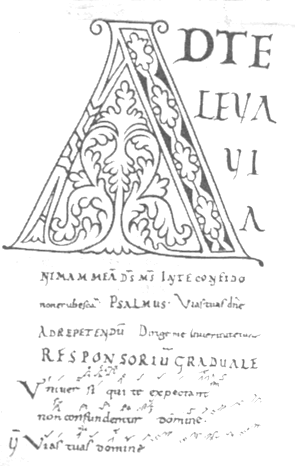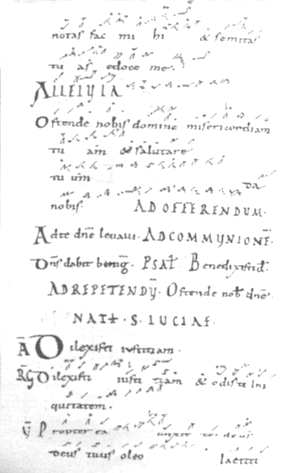|
Gregorian Chant and Medieval Music
in
New York City
by
There were many types of music in the Middle Ages:
- Songs representing knights riding into battle
- Songs and dances for the nobles celebrating in their castles
- Chants for priests, monks and nuns, as they rejoiced in the
Christian service in the cathedrals and monasteries.
Much of the music from this era, except for modern re-creations,
is now lost. A good deal of church music is preserved, however,
because priests and nuns (to a lesser extent) were among the best-educated
people, and their institutions and libraries lasted longer. Monks
were encouraged to read and write in order to learn about the
scriptures, and it was they who devised a system to copy music.
Nevertheless, much of what passes for "Medieval" music
today actually represents a reconstruction of the old manuscripts
done, especially, by the Monks of Solesmes Abbey in France in
the nineteenth century.
This page presents some indications of where Gregorian Chant can
be heard in New York City.
A. Gregorian Chant
 What
we today call Gregorian Chant was sung daily at the monastic
hours of prayer and at mass. Chant was named in honor of Pope
Gregory the Great who had insisted that certain chants be sung
on certain days of the liturgical year. Another for this music
is "plainsong". What
we today call Gregorian Chant was sung daily at the monastic
hours of prayer and at mass. Chant was named in honor of Pope
Gregory the Great who had insisted that certain chants be sung
on certain days of the liturgical year. Another for this music
is "plainsong".
The images here are from an actual Gregorian Chant manuscript
taken from a book by Louis Lambillotte, of a chant that was composed
during the course of fifteen centuries.
Each mark above the words represents a stroke, which denotes an
elevation of voice. Depending upon what shape the accent is determines
the degree of elevation. Gregorian chant has neither meter nor
regular rhythm. There are no obvious patterns and the music is
intended to encourage pious reflection.
The authorship of much plainsong is anonymous. But some composers
are known. With some composers of Gregorian Chant, it seems that
they believed themselves to be expressing the voice of God, actual
vessels in which the message of divine authority might be channeled
to those on earth.
One of the most extraordinary contributors to the collection of
Gregorian Chant was Abbess Hildegarde of Bingen (1098-1171). She contributed over seventy-seven chants to the
collection  of
Gregorian chant. During powerful religious experiences, she saw
images such as "the breath of Satan in guise of a serpent,
the fiery descent of the Holy Spirit, and the blood of Christ
steaming in the heavens." The images she saw were communicated
through her poetry, which was set to music as liturgical chant-
Gregorian Chant. [A very popular modern recording, somewhat jazzed
up with New Age instrumentation is called Vision, a recording
of seventeen of her compositions. More authentic recordings also
exist.] of
Gregorian chant. During powerful religious experiences, she saw
images such as "the breath of Satan in guise of a serpent,
the fiery descent of the Holy Spirit, and the blood of Christ
steaming in the heavens." The images she saw were communicated
through her poetry, which was set to music as liturgical chant-
Gregorian Chant. [A very popular modern recording, somewhat jazzed
up with New Age instrumentation is called Vision, a recording
of seventeen of her compositions. More authentic recordings also
exist.]
B. Musical Portions of
the Mass
This is where a distinction made as to when certain chants are
sung. The greatest part of monastic prayer consisted o the "Office
of Hours", which was largely composed of settings of Psalms
and canticles [texts taken from the Old or New Testaments.] Much
of the most impressive Chant is connected with Musical Portions
of the Mass. Music for mass falls into two main categories:
- Music for the Ordinary of the Mass: - chants with unvarying
content that were sung practically every day.
- Music for the Proper of the Mass, chants whose content
changed to represent the day - weekday, Sunday, or feast day -
being celebrated
Musical Parts of the Ordinary of the Mass
- Kyrie- a petition of Mercy.
- Gloria- a hymn of praise to the Lord.
- Credo- a profession of faith.
- Sanctus- an acclimation to the Lord.
- Agnus Dei- a petition for mercy and eternal peace.
Musical Parts of the Proper of the Mass
- Introit- an introductory chant for the entry of the celebrating
clergy.
- Gradual- a reflective chant.
- Alleluia or Tract- a chant off thanksgiving or penance.
- Sequentia- a chant commenting on the text of the Alleluia.
- Offertory- a chant or the offering.
- Communion- a chant for communion.
There is a full text and translation of Ordinary of the Latin Mass available.
C. Medieval Music in New
York City
In our search for medieval music in New York City, we were able
to find three main Roman Catholic churches often use Gregorian
chant and medieval music. There is also an exhibit in the Metropolitan
Museum on early medieval music and concerts can be heard throughout
the year at the Cloisters, a section of the Met. The following
is a list of places with locations and phone numbers in New York
City that medieval music can be heard:
- Corpus Christi Church, West 121st between Amsterdam and Broadway
(212) 666-9350
- St. Agnes Church, East 44th between Lexington and 3rd Ave
(212) 682-5722
- St. Ann's Church, East 12th street, near 3rd Ave
- Metropolitan Museum, 82nd and 5th Ave.(212) 535-7710
- The Cloisters (a branch of the
Met for medieval art and music), Fort Tryon Park at the northern
tip of Manhattan Island
D. Sample Modern Recordings
of Medieval Music
In recent years, modern recording have been produced, sweeping
the nation with a new found popularity.
- The Benedictine Monks of the Santo Domingo De Silos
- Chant I, II, and II- (Angel Records,
1994-1996). [The first CD sold a million copies in the US within
the first 2 months of its release.]
- Easter Chants
- Gregorian Chant from Spain
- Chant Noel- chant for the Holiday season.
- Gregorian Chant- Schola Hungarica
- Magyan Gregorianum 3:
- Gregorian Chants from Medieval Hungary
- Holy Week
- Gregorian Chant
- Choir of the Monks from the Abbey of St. Peter, Solesmes
- The Selected 1930 French HMV Recordings of the Monastic Choir
- Missa de Angelis (The Mass of the Angels) Gregorian
Chant from the Abbey of St. Michael's.
- Russian Liturgical Chants
A combination of many Russian artists including: Dmitri Bortnyanshy,
Fyodor Lvovsky Nikolai Rimsky-Korsakov Alexander Gretchninov
- Byzantine Music of the Greek Orthodox Church
- Volume 2- The Divine liturgy of St. John Chrysostom
- Volume 4- Hymns of the Holy Week (a cappella)
- Volume 9- David's Psalms
Gregorian Chant Links
Back to Medieval New York Page
This Page is part of the Medieval New York Web Project, a project of students in the Introduction to Medieval History courses taught by Paul Halsall in the History Department of Fordham University in
1996-1997.
© Copyright to the student creator of each page.
The Internet History Sourcebooks Project is located at the History Department of Fordham University, New York. The Internet
Medieval Sourcebook, and other medieval components of the project, are located at
the Fordham University Center
for Medieval Studies.The IHSP recognizes the contribution of Fordham University, the
Fordham University History Department, and the Fordham Center for Medieval Studies in
providing web space and server support for the project. The IHSP is a project independent of Fordham University. Although the IHSP seeks to follow all applicable copyright law, Fordham University is not
the institutional owner, and is not liable as the result of any legal action.
© Site Concept and Design: Paul Halsall created 26 Jan 1996: latest revision 12 April 2024 [CV]
|